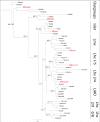Lim homeobox genes in the Ctenophore Mnemiopsis leidyi: the evolution of neural cell type specification
- PMID: 22239757
- PMCID: PMC3283466
- DOI: 10.1186/2041-9139-3-2
Lim homeobox genes in the Ctenophore Mnemiopsis leidyi: the evolution of neural cell type specification
Abstract
Background: Nervous systems are thought to be important to the evolutionary success and diversification of metazoans, yet little is known about the origin of simple nervous systems at the base of the animal tree. Recent data suggest that ctenophores, a group of macroscopic pelagic marine invertebrates, are the most ancient group of animals that possess a definitive nervous system consisting of a distributed nerve net and an apical statocyst. This study reports on details of the evolution of the neural cell type specifying transcription factor family of LIM homeobox containing genes (Lhx), which have highly conserved functions in neural specification in bilaterian animals.
Results: Using next generation sequencing, the first draft of the genome of the ctenophore Mnemiopsis leidyi has been generated. The Lhx genes in all animals are represented by seven subfamilies (Lhx1/5, Lhx3/4, Lmx, Islet, Lhx2/9, Lhx6/8, and LMO) of which four were found to be represented in the ctenophore lineage (Lhx1/5, Lhx3/4, Lmx, and Islet). Interestingly, the ctenophore Lhx gene complement is more similar to the sponge complement (sponges do not possess neurons) than to either the cnidarian-bilaterian or placozoan Lhx complements. Using whole mount in situ hybridization, the Lhx gene expression patterns were examined and found to be expressed around the blastopore and in cells that give rise to the apical organ and putative neural sensory cells.
Conclusion: This research gives us a first look at neural cell type specification in the ctenophore M. leidyi. Within M. leidyi, Lhx genes are expressed in overlapping domains within proposed neural cellular and sensory cell territories. These data suggest that Lhx genes likely played a conserved role in the patterning of sensory cells in the ancestor of sponges and ctenophores, and may provide a link to the expression of Lhx orthologs in sponge larval photoreceptive cells. Lhx genes were later co-opted into patterning more diversified complements of neural and non-neural cell types in later evolving animals.
Figures






Similar articles
-
Early evolution of the LIM homeobox gene family.BMC Biol. 2010 Jan 18;8:4. doi: 10.1186/1741-7007-8-4. BMC Biol. 2010. PMID: 20082688 Free PMC article.
-
Nuclear receptors from the ctenophore Mnemiopsis leidyi lack a zinc-finger DNA-binding domain: lineage-specific loss or ancestral condition in the emergence of the nuclear receptor superfamily?Evodevo. 2011 Feb 3;2(1):3. doi: 10.1186/2041-9139-2-3. Evodevo. 2011. PMID: 21291545 Free PMC article.
-
Genomic organization, evolution, and expression of photoprotein and opsin genes in Mnemiopsis leidyi: a new view of ctenophore photocytes.BMC Biol. 2012 Dec 21;10:107. doi: 10.1186/1741-7007-10-107. BMC Biol. 2012. PMID: 23259493 Free PMC article.
-
Convergent evolution of neural systems in ctenophores.J Exp Biol. 2015 Feb 15;218(Pt 4):598-611. doi: 10.1242/jeb.110692. J Exp Biol. 2015. PMID: 25696823 Free PMC article. Review.
-
Think like a sponge: The genetic signal of sensory cells in sponges.Dev Biol. 2017 Nov 1;431(1):93-100. doi: 10.1016/j.ydbio.2017.06.012. Epub 2017 Jun 21. Dev Biol. 2017. PMID: 28647138 Review.
Cited by
-
The LIM and POU homeobox genes ttx-3 and unc-86 act as terminal selectors in distinct cholinergic and serotonergic neuron types.Development. 2014 Jan;141(2):422-35. doi: 10.1242/dev.099721. Epub 2013 Dec 18. Development. 2014. PMID: 24353061 Free PMC article.
-
Expression of the Lhx genes apterous and lim1 in an errant polychaete: implications for bilaterian appendage evolution, neural development, and muscle diversification.Evodevo. 2013 Feb 1;4(1):4. doi: 10.1186/2041-9139-4-4. Evodevo. 2013. PMID: 23369627 Free PMC article.
-
Nitric oxide signaling in ctenophores.Front Neurosci. 2023 Mar 22;17:1125433. doi: 10.3389/fnins.2023.1125433. eCollection 2023. Front Neurosci. 2023. PMID: 37034176 Free PMC article.
-
Integrating Embryonic Development and Evolutionary History to Characterize Tentacle-Specific Cell Types in a Ctenophore.Mol Biol Evol. 2018 Dec 1;35(12):2940-2956. doi: 10.1093/molbev/msy171. Mol Biol Evol. 2018. PMID: 30169705 Free PMC article.
-
Multigenerational laboratory culture of pelagic ctenophores and CRISPR-Cas9 genome editing in the lobate Mnemiopsis leidyi.Nat Protoc. 2022 Aug;17(8):1868-1900. doi: 10.1038/s41596-022-00702-w. Epub 2022 Jun 13. Nat Protoc. 2022. PMID: 35697825 Review.
References
LinkOut - more resources
Full Text Sources
Research Materials

